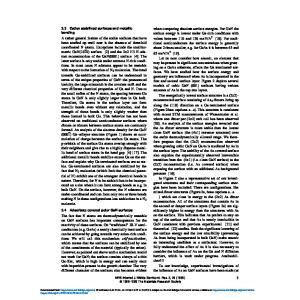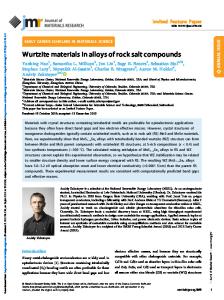Cubic ZnMgO Alloys Offer Alternative to III-Nitride Wurtzite Structure
- PDF / 78,300 Bytes
- 1 Pages / 612 x 792 pts (letter) Page_size
- 75 Downloads / 408 Views
To recreate bone’s nanostructure in the laboratory, Stupp and his team designed a cone-shaped molecule, a peptide-amphiphile, that is bulkier and hydrophilic on one end (a peptide) and slimmer and hydrophobic on the other (an alkyl group). When in water at low pH, the molecules assemble themselves like spokes on a wheel, with the hydrophobic greasy tail directed to the center, leaving the peptide to face the exterior aqueous environment. This basic structure is repeated so that a long nanofiber is formed, similar to an insulated copper wire where the insulation is the peptide and the wire is the alkyl group. The synthetic fibers orient the growth of the hydroxyapatite crystals so that they mimic the structure found in natural bone. The researchers engineered their peptide structure to attract bone cells, but the chemistry of the peptide is customizable, said Stupp, and can be changed to attract different cells to the fibrous scaffold, such as neurons, cartilage, muscle, liver, and pancreas cells. Stupp said, “We’ve mimicked this for bone, but we have offered a strategy that would work for other tissues of the human body, or to create materials inspired by bone that could be useful in electronics or photonics.”
Electrical Conductivity of Single-Molecule Wires Accurately Measured Researchers from Arizona State University have determined a method for creating through-bond electrical contacts with single molecules, enabling them to achieve reproducible measurements of the molecules’ conductivity. ASU chemistry professor Devens Gust said, “Progress in the field has been hampered by two problems. The first has been in making robust, reproducible electrical connections to both ends of molecules. After this has been achieved, the next problem is knowing how many molecules there actually are between the electrical contacts.” As reported in the October 19, 2001, issue of Science, the researchers began with a uniform atomic layer of gold atoms and attached octanethiol insulator molecules to it through chemical bonds, forming a coating of aligned molecules. Using a solvent, they removed some of the insulators and replaced them with molecules of 1,8-octanedithiol, a molecule that is similar but capable of bonding with gold at both ends and acting as a molecular “wire.” Gold 2-nm particles were then added to the solvent, where they bonded to the free ends of the 1,8-octanedithiol mole86
cules, thus creating a bonded metallic contact at either end of the conducting molecules. A gold-coated conducting atomic force microscope probe was then run across the surface and conductivity was measured when it made contact with the gold particles. When electrical measurements were made on over 4000 gold particles, virtually all measurements fell into one of five groups of distinct conductivity curves, according to the researchers. The conductivity curves were distinct whole-number multiples of a single, fundamental curve, they said. The researchers said that the fundamental curve represents conduction by a single molecule of octanedithiol
Data Loading...











